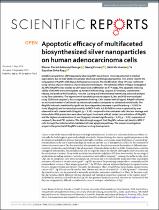 ResearchSpace
ResearchSpace
Apoptotic efficacy of multifaceted biosynthesized silver nanoparticles on human adenocarcinoma cells
JavaScript is disabled for your browser. Some features of this site may not work without it.
- ResearchSpace
- →
- Research Publications/Outputs
- →
- Journal Articles
- →
- View Item
| dc.contributor.author |
George, BPA

|
|
| dc.contributor.author |
Kumar, Neeraj

|
|
| dc.contributor.author |
Abrahamse, H

|
|
| dc.contributor.author |
Ray, Suprakas S

|
|
| dc.date.accessioned | 2019-03-05T10:02:49Z | |
| dc.date.available | 2019-03-05T10:02:49Z | |
| dc.date.issued | 2018-09 | |
| dc.identifier.citation | George, B.P.A. et al. 2018. Apoptotic efficacy of multifaceted biosynthesized silver nanoparticles on human adenocarcinoma cells. Scientific reports, vol. 8(14368): DOI:10.1038/s41598-018-32480-5 | en_US |
| dc.identifier.issn | 2045-2322 | |
| dc.identifier.uri | https://www.nature.com/articles/s41598-018-32480-5 | |
| dc.identifier.uri | http://hdl.handle.net/10204/10739 | |
| dc.description | Article published in Scientific reports: DOI:10.1038/s41598-018-32480-5 | en_US |
| dc.description.abstract | Metallic nanoparticles (NPs) especially silver (Ag) NPs have shown immense potential in medical applications due to their distinctive physio-chemical and biological properties. This article reports the conjugation of Ag NPs with Rubus fairholmianus extract. The modification of Ag NPs was confirmed using various physico-chemical characterization techniques. The cytotoxic effect of Rubus-conjugated Ag NPs (RAgNPs) was studied by LDH assay and proliferation by ATP assay. The apoptotic inducing ability of the NPs were investigated by Annexin V/PI staining, caspase 3/7 analysis, cytochrome c release, intracellular ROS analysis, Hoechst staining and mitochondrial membrane potential analysis using flow cytometry. The expression of apoptotic proteins caspase 3, Bax and P53 were analyzed using ELISA and caspase 3, Bax using western blotting. Cells treated with 10-µg/mL RAgNPs showed an increased number of cell death by microscopic analysis compared to untreated control cells. The RAgNPs induced a statistically significant dose-dependent decrease in proliferation (p<0.001 for 5 and 10µg/mL) and increased cytotoxicity in MCF-7 cells. A 1.83 fold increase in cytotoxicity was observed in cells treated with 10µg/mL (p<0.05) compared to the untreated cells. Nuclear damage and intracellular ROS production were observed upon treatment with all tested concentrations of RAgNPs and the highest concentrations (5 and 10µg/mL) showed significant (p<0.05, p<0.01) expression of caspase 3, Bax and P53 proteins. The data strongly suggest that RAgNPs induces cell death in MCF-7 cells through the mitochondrial-mediated intrinsic apoptosis pathway. The present investigation supports the potential of RAgNPs in anticancer drug development. | en_US |
| dc.language.iso | en | en_US |
| dc.publisher | Nature Publishing Group | en_US |
| dc.relation.ispartofseries | Worklist;22059 | |
| dc.subject | Metallic nanoparticles | en_US |
| dc.subject | Medical applications | en_US |
| dc.subject | Human adenocarcinoma cells | en_US |
| dc.title | Apoptotic efficacy of multifaceted biosynthesized silver nanoparticles on human adenocarcinoma cells | en_US |
| dc.type | Article | en_US |
| dc.identifier.apacitation | George, B., Kumar, N., Abrahamse, H., & Ray, S. S. (2018). Apoptotic efficacy of multifaceted biosynthesized silver nanoparticles on human adenocarcinoma cells. http://hdl.handle.net/10204/10739 | en_ZA |
| dc.identifier.chicagocitation | George, BPA, Neeraj Kumar, H Abrahamse, and Suprakas S Ray "Apoptotic efficacy of multifaceted biosynthesized silver nanoparticles on human adenocarcinoma cells." (2018) http://hdl.handle.net/10204/10739 | en_ZA |
| dc.identifier.vancouvercitation | George B, Kumar N, Abrahamse H, Ray SS. Apoptotic efficacy of multifaceted biosynthesized silver nanoparticles on human adenocarcinoma cells. 2018; http://hdl.handle.net/10204/10739. | en_ZA |
| dc.identifier.ris | TY - Article AU - George, BPA AU - Kumar, Neeraj AU - Abrahamse, H AU - Ray, Suprakas S AB - Metallic nanoparticles (NPs) especially silver (Ag) NPs have shown immense potential in medical applications due to their distinctive physio-chemical and biological properties. This article reports the conjugation of Ag NPs with Rubus fairholmianus extract. The modification of Ag NPs was confirmed using various physico-chemical characterization techniques. The cytotoxic effect of Rubus-conjugated Ag NPs (RAgNPs) was studied by LDH assay and proliferation by ATP assay. The apoptotic inducing ability of the NPs were investigated by Annexin V/PI staining, caspase 3/7 analysis, cytochrome c release, intracellular ROS analysis, Hoechst staining and mitochondrial membrane potential analysis using flow cytometry. The expression of apoptotic proteins caspase 3, Bax and P53 were analyzed using ELISA and caspase 3, Bax using western blotting. Cells treated with 10-µg/mL RAgNPs showed an increased number of cell death by microscopic analysis compared to untreated control cells. The RAgNPs induced a statistically significant dose-dependent decrease in proliferation (p<0.001 for 5 and 10µg/mL) and increased cytotoxicity in MCF-7 cells. A 1.83 fold increase in cytotoxicity was observed in cells treated with 10µg/mL (p<0.05) compared to the untreated cells. Nuclear damage and intracellular ROS production were observed upon treatment with all tested concentrations of RAgNPs and the highest concentrations (5 and 10µg/mL) showed significant (p<0.05, p<0.01) expression of caspase 3, Bax and P53 proteins. The data strongly suggest that RAgNPs induces cell death in MCF-7 cells through the mitochondrial-mediated intrinsic apoptosis pathway. The present investigation supports the potential of RAgNPs in anticancer drug development. DA - 2018-09 DB - ResearchSpace DP - CSIR KW - Metallic nanoparticles KW - Medical applications KW - Human adenocarcinoma cells LK - https://researchspace.csir.co.za PY - 2018 SM - 2045-2322 T1 - Apoptotic efficacy of multifaceted biosynthesized silver nanoparticles on human adenocarcinoma cells TI - Apoptotic efficacy of multifaceted biosynthesized silver nanoparticles on human adenocarcinoma cells UR - http://hdl.handle.net/10204/10739 ER - | en_ZA |





